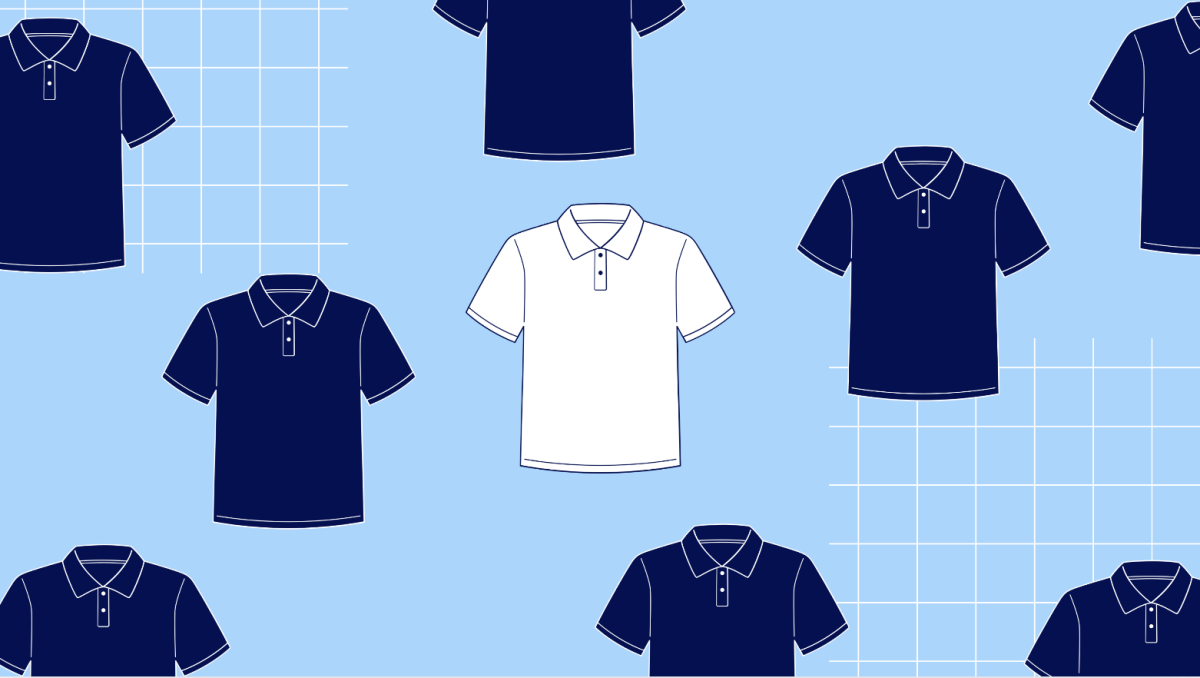When strolling through the Castilleja campus, there are many things to be noted. Uniform and tech violations, ping pong games, panicked studying and much more. However, one thing consistently rings true for students around campus: the popularity of the navy polo. While the school offers both white and navy polos, it seems as though students favor navy. If you, like me, are curious to discover why, then we have to start from the beginning.
The interesting thing about the polo’s lore is that Castilleja hasn’t always had it as an available option. The polo itself was only added to the school’s uniform in the late 1980s — before that, only white middy tops were allowed.
“[Students] were only allowed two options: the middy blouse that went over your head, and a blouse with what is called a ‘Peter Pan’ collar, a very round collar that buttoned up,” Liz Babb ’82 said.
The first polo added was the white polo, and a couple years later, the navy slotted itself into the uniform ensemble. The most fascinating part of this is that there was actually a third, secret color: red. However, due to the fact that every company made a different shade of red, the polo lost popularity fast, and eventually Dennis Uniforms, the company that Castilleja sources uniforms from, stopped selling them. Elizabeth Wright ’03 said that students “could only wear Casti red polos bought from the bookstore, not just any red polo.” Additionally, since red is such a bold color, many people felt that it stood out too much, with Pratima Sethi ‘94 commenting that “red [was a] least favorite color– too loud.”
Even when the navy polo was introduced to the school uniform, the white polo reigned supreme as it had been a staple in students’ wardrobes for a long time. Emily Ach ’00 noted that “white polos were easier to find in stores than navy,” an opinion held by many Castilleja alumni. Louise Honner ’95 shared that “white polo shirts were definitely favored over navy,” and its popularity continued into the 2000s, with Georgia Lewis ’18 commenting that white polos were beloved because they “made people look more tan.”
However, more recent Castilleja alumni shared the popularity of the navy polo, with Bella Vandenberg ’20, noting that it “hid stains and wrinkles better” — an opinion echoed by Michelle Leonard ’24 and Claire Traum ’17. Valerie Hammer ‘17 provided a variety of reasons for the navy’s superiority: noodle bar spills, concealing 2013 neon sports bras, and matching the pale blue uniform skirts better than the white polo. Former teacher Lauren Schryver commented that during her time teaching at Casti, “navy blue polos were more prevalent” than white ones.
This poses the question:does history always repeat itself? Did we as a school continue to grow in favor of the navy polo over the white? Do we value comfort or style more? In order to answer this colossal question, I conducted some research. Over the course of two weeks, I interviewed 100 Castilleja students on their polo preferences. The data was shocking.
Out of the 100 students, only seven supported the white polos over their navy counterparts.
This only further sparked my curiosity — I had to figure out why. I asked students about the logic behind their preferences and received a variety of answers. Poppy Scott ’27 remarked that the white polo was “too formal.” This sentiment was echoed by many people interviewed on this subject. Joan Lonergan, former Head of School, explained another take, sharing that middle school students tended to lean towards the navy, while Upper School students preferred the clean cut white.
Additionally, the shade of the polo plays a huge role in the choices of students. Adya Chowdhury ’27 shared that white polos “start looking old really fast.” Ellie Kang ’27 shared that she prefers “the way the navy polo looks” as it appears “clean paired with jewelry and looks better with [her] hair and skin.” Color matching remained the strongest reasoning behind navy polo love. Kaathya Seshaadri ’27 highlighted this as her main reason behind her navy polo preference, explaining that she likes “how navy goes with the skirt better.” This idea was repeated by many people who appreciate the contrast in color between the light blue skirt and dark blue polo. Nikita Ganesh ’27 went so far to say that “[the navy polo] is a symbol of connection, because [everyone wears it].”
While the polo is a symbol of Castilleja’s history, it represents far more. The white polo personifies danger and is the idealist and dreamer’s choice of shirt: fragile yet luminous. On the other hand, the navy polo is the realist’s choice. It exemplifies pragmatism and hides the wrinkles of imperfection. While the white was originally preferred because of its virtue, the navy has risen to the top due to its protection — we as a school are slowly valuing our defense from stains over the illusion of a tan that the white polo creates.
Essentially, the polos are not polos. They represent choice between beauty and comfort—and the struggle to balance them with the other Castilleja shirts —represents more than just a decision about the uniform itself. This preference for navy over white, practicality over purity, explains how as a school, we are leaning toward what is durable and what truly accommodates the complexities of living, rather than what is pristine but precarious.
Perhaps the real takeaway from these preferences is that we all seek comfort and functionality. Maybe the only thing we can agree on is to bring sweatpants back to the uniform.



